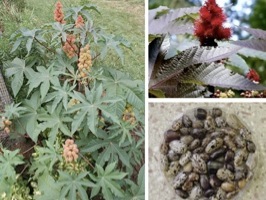Poisons






Since ancient times man has used toxins and various biological materials as a weapon. However, without modern science, the biological and chemical root of these poisons remained in the dark. As times changed and wars shifted from local power struggles to global conflicts though, scientific exploration on the use of biological warfare began. From the beginning of the 20th century up until as recently as 1970 most of the world’s most powerful countries conducted research and clinical tests on various biological agents to discover the practicality and potency of them as biological weapons, one of these substances was ricin.
Ricin comes from castor beans found on the castor plant (Ricinus communis) in regions of Asia, Middle East and southern Europe. Historical writings state that 6-7 castor beans are enough to kill a full grown man. Although ricin is present in castor beans, the vast majority of the chemical is found in the seed coating and as a result, the rest of the bean is quite harmless. In turn, the castor beans are also rich in oils containing triglycerides. As a result, many cultures learned that after the removal of the outer coating, the bean could be used medicinally as a laxative or purgative.
Since the relatively high lethality of the castor bean’s outer shell was historically well known, scientist began to conduct studies on the bean, which in turn lead to the discovery and mode of action of ricin. What they discovered was that ricin is a so called AB-toxin. An AB-toxin works by their being an active enzyme part (A) that is responsible for the damage and a binding part (B) that navigates the toxin to the desired destination. Ricin performs this by being a single polypeptide chain in which the B (ricin B-chain) is a lectin that binds to either a glycoprotein or a glycolipid which thus allows it to travel through the Golgi network to the endoplasmic reticulum. Then, A (ricin A-chain) seperates from part B allowing it to cross the endoplasmic reticulum and once inside the cell, it acts as a ‘ribosome inactivating protein’ thus stopping the biosynthesis of proteins.
In turn, because of the mode in which ricin reacts, clinical studies have shown that it is not a cell-specific toxin and that the toxicity of ricin is 3-5µg/kg body weight making it by weight roughly 400 times deadlier than the mold Trichoderma ligorum and twice as deadly as puffer fish and marine bacteria. The effects of ricin begin to occur 2-24 hours after digestion/inhalation depending on the dose and initial inhalation symptoms are characterized by breathing difficulties, fever, cough, nausea, and tightness of chest. In lethal doses this then leads to heavy sweating, pulmonary edema, the victims becoming cyanotic, and finally high blood pressure and respiratory failure causing death.
Consequently, ricin has become a major threat and possible agent of terrorist attack. The raw material, castor beans, is easily available and through uncomplicated chemical procedures, large amounts of crude extract can easily be obtained. Also since ricin affects all cells crude aerosols of any size particle would be affective at harming people. As a result, a terrorist sector can easily obtain the materials required and at a relatively low price, produce a very deadly biological weapon.
Although ricin poisoning is a serious threat, scientists are studying compounds in hopes of finding an antidote for the poison. Currently sugar analogues have been found to be effective at inhibiting the binding of ricin to its target and also the AIDS drug azidothymidine might be used as an antidote in the future. Thus far though, current therapy for poisoning only includes the use of artificial respiration, replacement of electrolytes, and medication to prevent seizures and low blood pressure.
Gas! Gas! Quick, boys! An ecstasy of fumbling,
Fitting the clumsy helmets just in time,
But someone still was yelling out and stumbling
And floundering like a man in fire or lime.
Dim through the misty panes and thick green light,
As under a green sea, I saw him drowning.
In all my dreams, before my helpless sight,
He plunges at me, guttering, choking, drowning.
-Wilfred Owen, Dulce et Decorum est (1917)
Monday, October 12, 2009



Ricin





